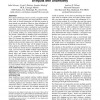76 search results - page 12 / 16 » Modeling and recognition of actions through motor primitives |
UIST
2010
ACM
13 years 6 months ago
2010
ACM
New input technologies (such as touch), recognition based input (such as pen gestures) and next-generation interactions (such as inexact interaction) all hold the promise of more ...
CHI
2010
ACM
14 years 3 months ago
2010
ACM
When asked to draw, many people are hesitant because they consider themselves unable to draw well. This paper describes the first system for a computer to provide direction and fe...
JMLR
2010
13 years 3 months ago
2010
In general, imitation is imprecisely used to address different levels of social learning from high level knowledge transfer to low level regeneration of motor commands. However, t...
ISVC
2007
Springer
14 years 2 months ago
2007
Springer
Abstract. Understanding intent is an important aspect of communication among people and is an essential component of the human cognitive system. This capability is particularly rel...
ICANN
2010
Springer
13 years 7 months ago
2010
Springer
Trajectory formation is one of the basic functions of the neuromotor controller. In particular, reaching, avoiding, controlling impacts (hitting), drawing, dancing and imitating ar...

